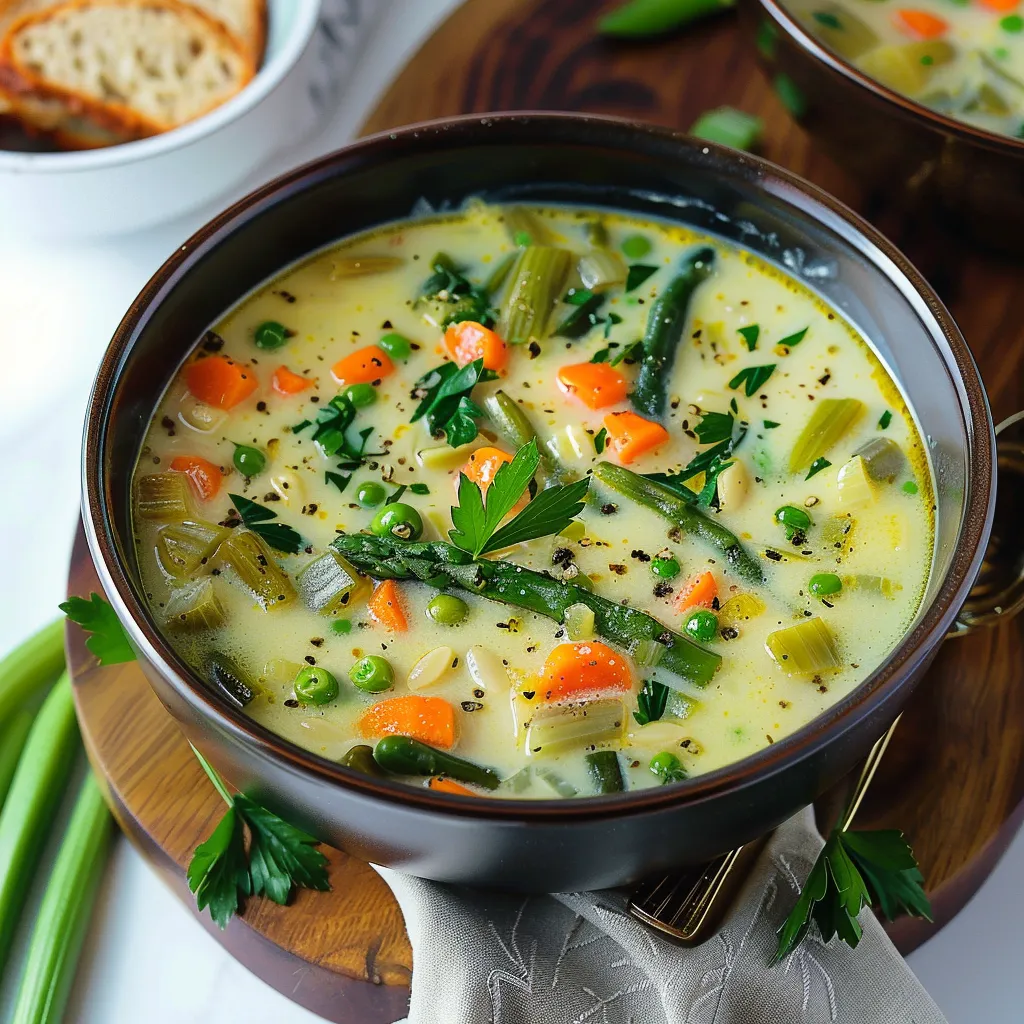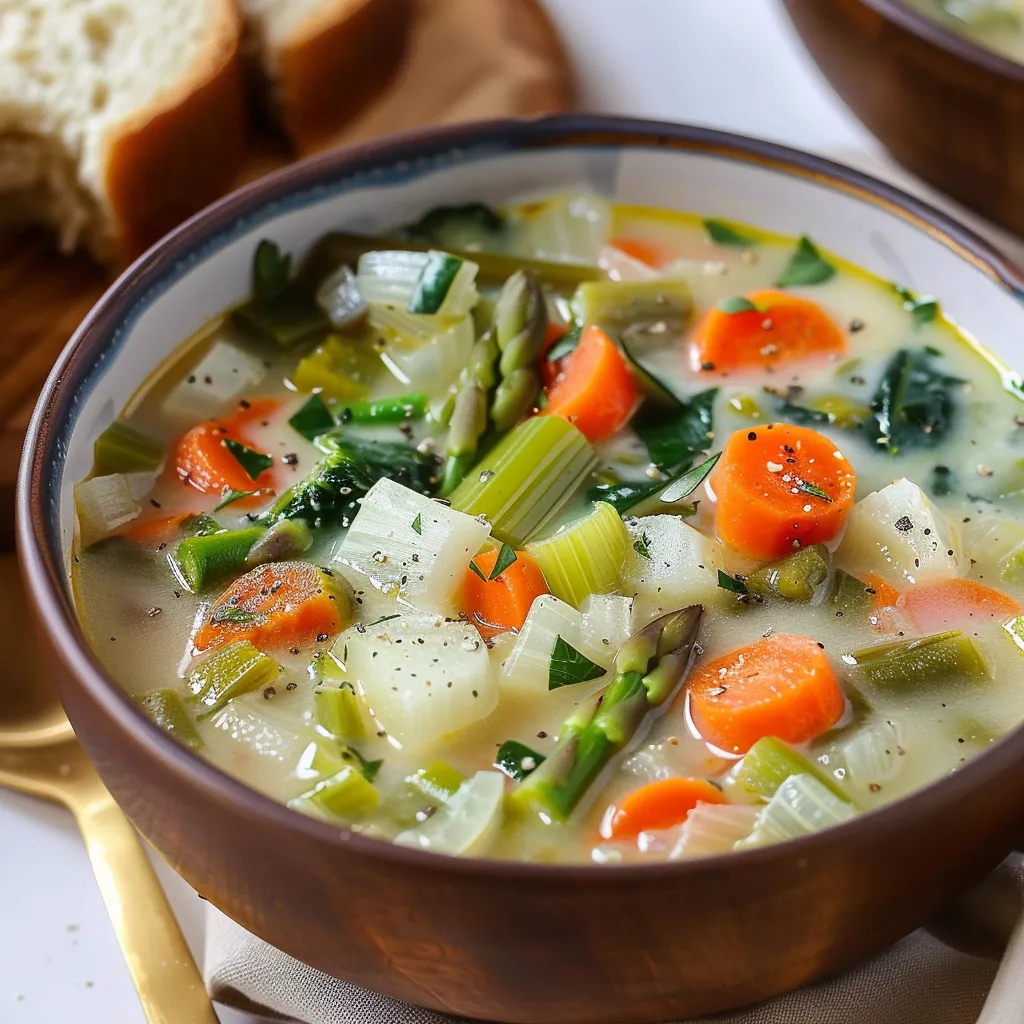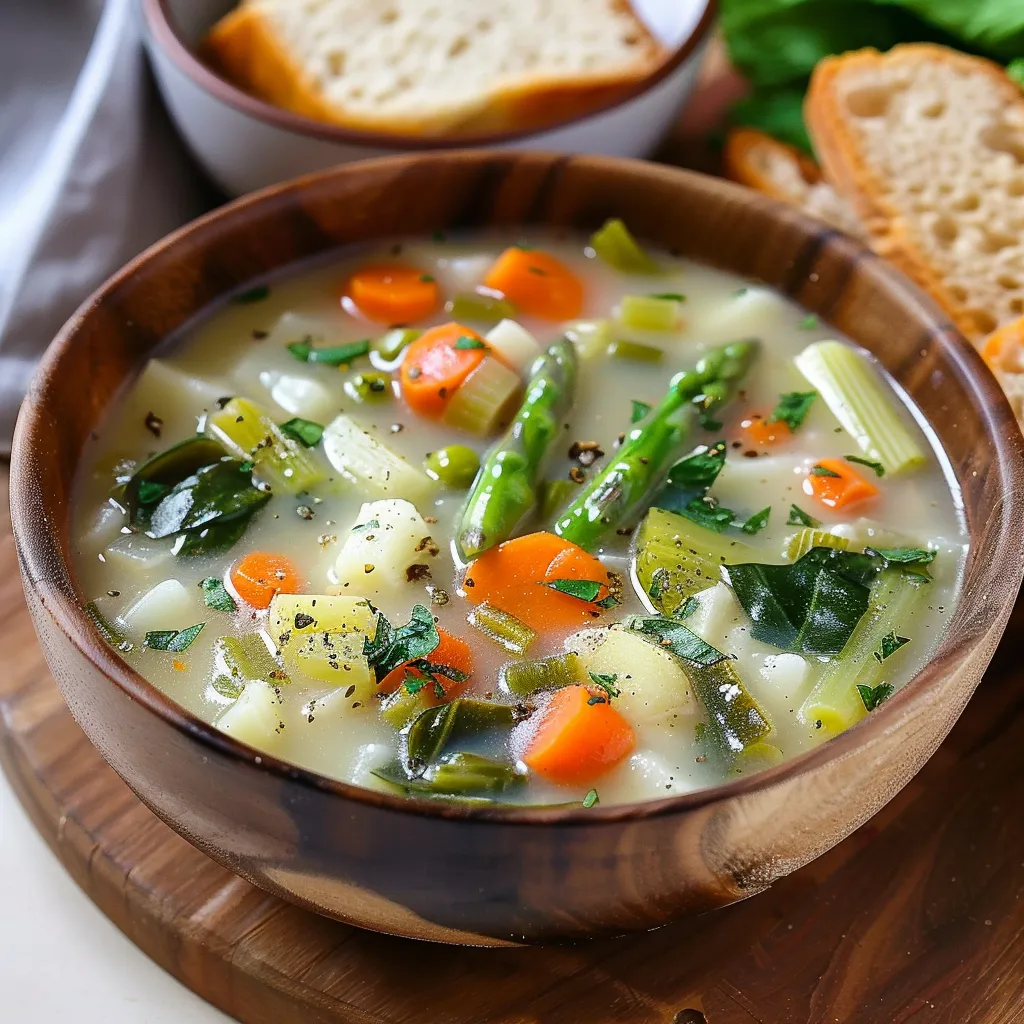 Pin it
Pin it
This delightful French spring soup brings together the season's freshest produce in a smooth, warming dish that highlights traditional European cooking at its finest. Every bite offers a blend of soft spring veggies in a rich broth that perfectly sits between substantial and refreshing.
I came up with this soup when I couldn't resist the gorgeous spring harvest at my neighborhood farmers market. It's now become our go-to Sunday night meal during springtime when we're looking for something cozy yet not too heavy as the days get warmer.
Ingredients
- Olive oil: Forms the taste foundation; go for a quality cold-pressed one if you can
- Large onion: Gives that crucial flavor base; grab the newest ones for extra sweetness
- Garlic cloves: Bring richness and layers; look for ones with tight, firm skin
- Carrots: Add natural sweetness and lovely color; the ones with bright tops are freshest
- Celery stalks: Give gentle herb notes and crunch; pick ones that snap crisply
- Leek: Brings mild sweetness; go for firm ones with bright green parts
- Asparagus: Offers that true spring flavor hit; thinner ones are usually softer
- Green beans: Add nice bite and freshness; they should snap cleanly when bent
- Vegetable or chicken broth: Makes up the soup's foundation; nothing beats homemade
- Heavy cream: Turns everything silky smooth; works better when not cold from the fridge
- Fresh spinach: Adds bright color and goodness; pick bunches with perky leaves
- Small pasta: Such as ditalini or orzo; gives each spoonful a satisfying chewiness
- Fresh herbs: Thyme and parsley lift the whole dish with their wonderful scent
Step-by-Step Instructions
- Sauté the Aromatics:
- Warm olive oil in a big Dutch oven over medium heat until it's slightly rippling. Toss in your chopped onion and let it cook about 5 minutes, giving it a stir now and then until it turns see-through but doesn't brown. This sets up all the flavors for your soup, letting the onion's natural sugars come out without burning.
- Build the Vegetable Base:
- Throw in your chopped garlic, carrots, and celery, keeping that medium heat going steady. Mix everything so it gets coated with oil and cook another 5 minutes. You want the veggies to start softening but still have some bite. This step really builds those deep flavor layers that make the soup special.
- Introduce Spring Vegetables:
- Add your sliced leek, asparagus, and green beans, folding them in with the other veggies. Let them cook 3-4 minutes so they start releasing their goodness while keeping their bright colors and texture. They'll keep cooking in the broth later, so keeping them a bit firm now means perfect texture at the end.
- Create the Broth Base:
- Add your broth and turn up the heat to get a gentle bubble going. Look for little bubbles at the edges that grow more active. Once it's bubbling, lower the heat to keep a steady simmer for 10 minutes. The veggies will soften while making the broth tasty. The liquid will reduce a bit, making the flavors stronger.
- Add Richness and Substance:
- Stir in the heavy cream and pasta, mixing gently to spread everything out. Let the soup keep simmering for however long your pasta package says, usually around 7-8 minutes. The pasta soaks up some of that tasty broth while cooking, and the cream makes everything velvety smooth, coating each veggie and pasta bit beautifully.
- Finish with Fresh Elements:
- Mix in the chopped spinach and thyme, stirring until the spinach softens into the soup, about a minute or so. The soup's heat will wilt the spinach just right while keeping its bright color and nutrients. The thyme adds that wonderful herb smell that pulls all the flavors together perfectly.
- Season and Serve:
- Give your soup a taste and add salt and pepper bit by bit, tasting between additions. Pour the finished soup into warm bowls and top with fresh parsley for a pop of color and fresh herb flavor. Eating it right away gets you the perfect temperature and texture.
 Pin it
Pin it
I think leeks are the hidden champion in this soup. They don't get as much attention as their stronger relative, the onion, but leeks add a gentle sweetness and smooth texture that makes the whole dish better. My grandma always put them in her spring soups and said they were what turned good soup into amazing soup.
Make It Ahead
You can make this soup up to two days early if you do one thing differently. Cook everything except adding the pasta, spinach, and herbs. Let it cool completely before putting it in the fridge in a sealed container. When you're ready to eat, warm it slowly on the stove until it bubbles, then add the pasta and finish the remaining steps. This stops the pasta from getting mushy or drinking up too much liquid.
Ingredient Substitutions
This soup really captures what spring cooking is all about - being flexible and working with what you've got. No asparagus around? Just throw in some fresh peas or fava beans instead. You can swap the cream for half and half if you want something lighter, or even try full-fat coconut milk for a dairy-free option with a hint of tropical flavor. The pasta can be switched for already-cooked rice or white beans if you want more protein.
Serving Suggestions
Enjoy this soup as a meal on its own with a hunk of crusty bread for soaking up that yummy broth. For a bigger dinner, add a simple green salad with a tangy dressing that'll work nicely against the creamy soup. This soup tastes great with a crisp white wine like Sauvignon Blanc or a light Pinot Grigio - their zingy taste cuts through the richness of the cream.
 Pin it
Pin it
This spring soup offers an amazing mix of fresh ingredients with classic cooking methods, just right for enjoying what the season has to offer.
Frequently Asked Questions
- → Can I skip the cream?
Absolutely! Swap out the heavy cream with coconut milk or a non-dairy cream for similar richness without dairy.
- → What's the best pasta to use?
Stick to smaller types of pasta like orzo, ditalini, or tiny shells for a nice texture balance with the veggies.
- → Can I save leftovers in the freezer?
Yes, but skip adding cream or pasta before freezing. Add them fresh when reheating for the best taste.
- → Can I change the veggies?
Yes, feel free to mix it up! Try adding peas, zucchini, or bell peppers—use what’s in season and available.
- → Any tips to boost flavor?
Cook the veggies longer to get a caramelized taste, then splash in some white wine before adding the broth for extra depth.
